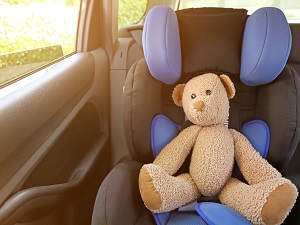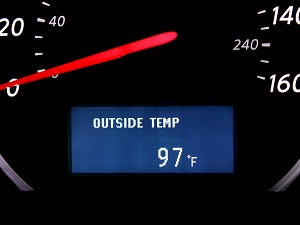Vehicular heatstroke is the official name of what happens when someone gets sick or dies inside of a car due to extreme heat. Babies and very young children are often the victims, but no one (including pets) should ever be left in a parked car in warm or hot temperatures.

The temperature inside a car can reach over 115°F when the outside temperature is just 70°F. In 10 minutes, a car’s temperature can rise about 20 degrees. Warning signs of heatstroke include:
- Red, hot, and moist or dry skin
- No sweating
- Strong, rapid pulse or slow, weak pulse
- Nausea
- Confusion or strange behavior
More than 50% of hot car deaths happen because someone forgets a child in a car. According to the National Highway Traffic Safety Administration (NHTSA), there are trends that have emerged from this tragic statistic.
- Typically, when a child was forgotten and left in a hot car, the caregiver meant to drop the child off at a daycare or preschool.
- Thursdays and Fridays at the end of the workweek have the highest number of deaths.
- More than half of the deaths are children under 2 years old.

For parents and caregivers of young children, there are several tricks you can use to make sure the child you are transporting is never left in a hot car.
Always look inside the car before locking the doors and walking away. An easy way to remember is to practice Park, Look, Lock.
Place a briefcase, purse, or cell phone next to the child’s car seat so that you’ll always check the back seat before leaving the car. This works with anything you know you need to grab before walking away from the vehicle.
Keep a stuffed animal or other memento in your child’s car seat when it’s empty and then move it to the front seat as a visual reminder when your child is in the back seat.
Ask your childcare provider to call you if your child doesn’t arrive as scheduled.
If someone else is driving your child, or your daily routine has been altered, always check to make sure your child has arrived safely.

The second leading cause of child deaths in hot cars happens when children get into unattended vehicles and can’t, or don’t, get out in time.
Always lock your vehicle, the doors and the trunk, all the time, year-round. Keep car keys out of children’s reach.
Never let children play in an unattended vehicle. Teach them that a vehicle is not a play area. If a child goes missing, quickly check all the vehicles nearby, including the trunks.
While all types of vehicular heatstroke deaths are preventable, the third leading cause of these deaths, knowingly leaving a child in a parked car, is the most preventable.
Never leave a child alone in a car, even with the windows rolled down or the air conditioning on. Don’t take the chance! Younger children are more sensitive to heat than older children and adults and are at greater risk for heatstroke. A child can die when their body temperature reaches 107 degrees.

If you see a child alone in a vehicle, try to get the child’s attention and notice if they seem alert and responsive. If not, call 911 immediately.
If the child appears to be okay, first attempt to locate the parents. If at a public place, have the facility page the car owner over an intercom system. Ensure someone stays with the child until help arrives.
If the child is not responsive and appears to be in distress, the NHTSA recommends that bystanders attempt to get into the car to assist the child—even if that means breaking a window.
Many states have “Good Samaritan” laws that protect people from lawsuits for getting involved to help a person in an emergency.

.jpeg)

.jpg)